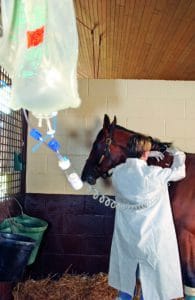
How Vibration Plates Impact Horse Hoof Growth
Results from a recent pilot study suggest that vibrating plates could help increase hoof growth rates when used consistently, but variably.


Results from a recent pilot study suggest that vibrating plates could help increase hoof growth rates when used consistently, but variably.

Two veterinarians share what has remained the same and what’s changing when it comes to diagnosing and treating this frustrating condition, once known as navicular. Read an excerpt from this in-depth article in our July 2018 issue.

Recognizing variations in strongyle populations across the country can help veterinarians refine parasite control recommendations depending on region, pasture access, horse age, and more.

Catheter complications in horses are rare, and in most cases the benefits of catheter use “far outweigh the risks,” researchers say.

At this time there’s no evidence that EIPH affects barrel racing horses’ performance, but more research on the topic is needed, scientists say.

When veterinarians detected pregnancy loss in horses early enough for mares to be rebred, 57.3% delivered a live foal the following spring. Of those, mares 3 to 8 years old had a 73% live-foaling rate.

Most EIA testing is done on a voluntary basis–owners aren’t necessarily required to test every horse at set intervals–making it very difficult to know the disease’s true prevalence, one researcher says.

Veterinary treatments for horses can be costly, so researchers evaluated the value an owner places on a horse’s daily use and how much owners are willingness to pay for various therapeutics.

Researchers were surprised that, given the frustration owners reported in trying to manage from insect bite hypersensitivity, veterinarians were not consulted more often or earlier in the course of the problem.

Most bloodworm-associated colic patients did not exhibit severe colic signs, which could make this potentially deadly condition difficult to diagnose, researchers found.

Whips, spurs, and horse-head-control equipment can be misused by riders and misunderstood by spectators, both of which can have negative outcomes for horses and the industry alike.

Seasoned sport horses often need a little extra TLC to continue performing well into middle age.

Horses that developed salmonellosis following colic surgery and survived to discharge did as well as those that did not develop salmonellosis.

Oral atropine has been associated with slowed gastrointestinal movement, but researchers found no evidence of this with topical application.

Researchers have determined that that some gastrointestinal lesions are more common in certain types of horses.

Mares discharged from the clinic following surgery have an excellent prognosis for survival and producing foals.
Stay on top of the most recent Horse Health news with